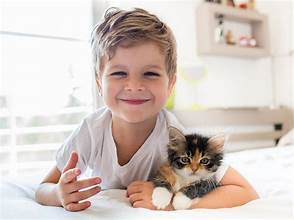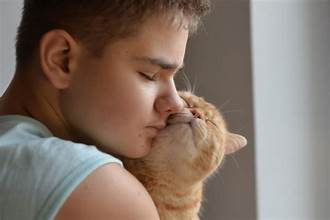How non-verbal children build powerful emotional bonds with comfort cats
The Unspoken Bond Between Cats and Non-Verbal Children
Traditional communication can be difficult for nonverbal children, whether due to autism, developmental delays, or trauma. However, many families have discovered that cats uniquely and soothingly bridge this communication gap. These gentle companions understand the language of stillness and respond beautifully to touch, eye contact, and quiet gestures, providing a unique form of emotional support.
Comfort Cats: Emotional Support Without Words, But Not Without Challenges
Cats don’t need sentences or speech. A non-verbal child doesn’t need to explain—they just need to be. Cats offer emotional support simply by being nearby. A calm cat sitting on a child’s lap or purring beside them during stressful moments can ease anxiety and promote safety.

Connection Through Touch and Eye Contact
Touch is often the first language between a cat and a child. Stroking a cat’s fur can regulate a child’s nervous system, lower stress, and encourage gentle physical interaction. Nonverbal children often build trust through shared routines—feeding, brushing, or simply sitting with their feline friend.
Pro Tip: Look for signs your cat is bonding too, like slow blinking, head nudges, or purring.
Emotional Development Through Feline Friendship
Cats teach nonverbal kids important emotional lessons. Children begin to recognize emotions like calm, excitement, or annoyance by observing their cat’s reactions. Some children even mirror these emotions, helping them understand and regulate their feelings in a quiet, low-pressure way.
Routine and Responsibility: Building Confidence
Caring for a pet provides structure that can comfort special needs children. Simple tasks like feeding, refreshing water bowls, or cleaning a litter box can give a nonverbal child a sense of purpose and routine, an essential part of their emotional development.

Real-Life Stories: The Quiet Breakthroughs
Many parents share emotional stories of their child’s first smile, laugh, or spoken word while bonding with a cat. For instance, a child with autism who had never shown interest in playing with others started engaging in interactive play with their cat. These moments, often unexpected, can mark huge milestones, sparked by trust and love between the child and their comfort cat.
Choosing the right comfort cat is crucial for providing the best support for a child with special needs. Here are some tips to help you make the best decision for your child:
When selecting a cat for a child with special needs:
- ✅ Opt for calm breeds like Ragdolls, British Shorthairs, or rescue cats known for gentle personalities
- ✅ Avoid high-energy or skittish cats that may not enjoy constant attention or physical contact
- ✅ Work with shelters that allow “meet and greet” sessions to see how your child and the cat respond to one another
Final Thoughts: Silent Love, Loud Impact
If you’re considering a pet for your nonverbal child, a comfort cat could be an excellent addition to your family. Cats don’t require conversations to offer love, which is perfect for nonverbal children. Their patient, peaceful nature allows for emotional healing, daily structure, and a sense of belonging. In their quiet way, these cats are everyday heroes—softly helping children thrive.



